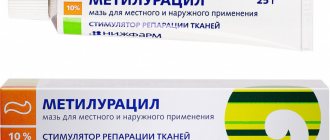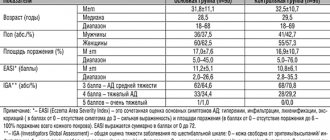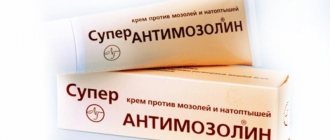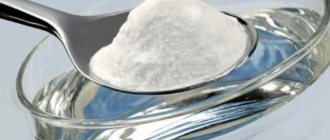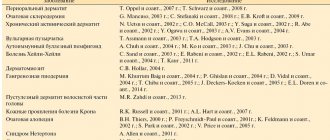Compound
Chondroxide tablets contain 1 pc. chondroitin sulfate 250 mg, as well as calcium stearate, crospovidone, microcrystalline cellulose, magnesium hydroxycarbonate - in the form of excipients.
1 g of gel for external use contains chondroitin sulfate 50 mg and additional substances: dimethyl sulfoxide, propylene glycol, isopropanol, ethanol, sodium disulfite, nipazole, nipagin, carbomer, orange food flavoring, water.
1 g of ointment for external use contains 50 mg of chondroitin sulfate
pharmachologic effect
Regulation of metabolism in cartilage tissue. Provides regeneration of cartilage tissue, chondrostimulation, anti-inflammatory effect.
Takes part in the construction of cartilage and bone tissue, improves metabolism in hyaline and fibrous cartilage. Inhibits degenerative changes in connective tissue and cartilage, ensures inhibition of enzymes that damage cartilage tissue.
Activates the synthesis of proteoglycans , regenerates the surface of the joints and joint capsule, stimulates the production of intra-articular fluid. Inhibits bone resorption, restores bone tissue and protects against calcium loss.
The drug slows down the development of osteochondrosis and osteoarthrosis, reduces pain in the affected joints. When taking the drug, the range of motion in the affected joints increases.
The use of the drug makes it possible to reduce the dosage of NSAIDs.
The gel relieves pain and inflammation.
Specialists
Lapshina S. A.1, 2
, Afanasyeva M.A.
2
, Sukhorukova E.V.
2
, Nigmatullina Z.N.3, Mingaleeva G.F.3
1Kazan State Medical University
2State Autonomous Institution "Republican Clinical Hospital of the Ministry of Health of the Republic of Tatarstan"»
3 State Autonomous Institution “City Clinical Hospital No. 7”, Kazan
Osteoarthritis is a chronic progressive disease of the joints, characterized by primary degeneration of articular cartilage with subsequent changes in the articular surfaces, subchondral bone, proliferation of marginal osteophytes and the development of deformities.
Osteoarthritis (OA) is the most common disease of the musculoskeletal system. According to WHO, OA affects about 4% of the world's population, and in 10% of cases it causes disability. The disease leads to a deterioration in the quality of life of patients and significant financial costs for both the patient and society as a whole. The economic damage associated with the incidence of OA in a number of countries ranges from 1 to 2.5% of the gross national product, including both direct costs of medical care and losses due to disability,
This disease is one of the main causes of premature disability and disability, second only to coronary heart disease in this regard, and the most common indication for joint replacement. According to multicenter epidemiological studies, the prevalence of OA among the population of the former USSR was 6.4% and correlates with age. According to rheumatologists in Europe and the USA, this disease accounts for up to 70% of all rheumatic diseases.
OA of the knee joint - gonarthrosis - accounts for 33.3% of all cases of OA (the second most common after OA of the hip joint). About 10% of the population over 55 years of age have signs of OA of the knee joints, while 25% of those suffering from gonarthrosis develop severe disability. The WHO report on the social impact of knee OA indicates that it is the 4th leading cause of disability in women and 8th in men. The annual incidence of arthroplasty operations among patients over 65 years of age suffering from gonarthrosis is 0.5-0.7 per 1000 population.
OA therapy is carried out in two directions - the use of analgesics and non-steroidal anti-inflammatory drugs (NSAIDs), which quickly relieve pain and inflammation in the joints, and the prescription of drugs aimed at slowing down the destruction of cartilage and the progression of the disease (glucosamine sulfate and chondroitin sulfate). The symptomatic effect of NSAIDs can reduce the intensity of pain, however, having a negative effect on the gastrointestinal tract, they do not prevent destructive changes in cartilage tissue and subchondral bone. Paracetamol recommended in guidelines in low doses has little effect on pain relief, and increasing doses sharply increases the risk of serious complications of therapy. Russia has accumulated quite a lot of experience in using drugs based on glucosamine sulfate. Glucosamine sulfate has chondroprotective properties, reduces the deficiency of glycosaminoglycans in the body, is a specific substrate and stimulator of the synthesis of hyaluronic acid and proteoglycans. Glucosamine sulfate helps restore the cartilage surfaces of peripheral joints and spinal joints. Has anti-inflammatory and analgesic properties. Reduces pain and the need to take non-steroidal anti-inflammatory drugs, inhibits the formation of superoxide radicals and enzymes that damage cartilage tissue (collagenase and phospholipase). An original solution to the possibility of using GS drugs was the creation of dosage forms for external use. When using drugs with chondroprotective properties, the effect usually occurs within 4-8 weeks from the start of treatment. This effect is expressed not only in slowing down the destruction of cartilage, but also in reducing pain. It should also be emphasized that no severe adverse reactions have been reported when taking them.
The purpose of this study is to evaluate the effectiveness and safety of Chondroxide® Maximum, a cream for external use, in the treatment of osteoarthritis of the knee joint. The effectiveness of therapy with Chondroxide® Maximum was compared with the data obtained during therapy with Dona, solution for intramuscular administration, in a group of patients with a similar diagnosis according to a standard treatment regimen.
A comprehensive examination was carried out on 40 patients with OA of the knee joints and severe pain syndrome aged from 48 to 75 years (average age - 56.7±8.2 years), of which 38 (95%) were women and 2 (5%) men. All patients had a verified diagnosis of knee OA and gonarthrosis (Altman RD criteria, 1995). The duration of the disease varied from 2 to 15 years (the average “experience” was 6.7±2.9 years). The X-ray stage of gonarthrosis according to Kellegren-Lawrence was determined as II – in 30 (75%) patients, III – in 10 (25%) people.
Concomitant pathologies were identified: arterial hypertension - in 24 (60%), coronary heart disease - in 12 (30%), chronic gastroduodenitis - 28 (70%), varicose veins of the lower extremities - in 22 (55%).
At the time of examination, all 40 (100%) patients were taking nonsteroidal anti-inflammatory drugs (NSAIDs).
The patients were divided into 2 groups of 20 people, comparable in basic parameters. The first group received local Chondroxide® Maximum, 3 cm of cream on the affected joint area up to 3 times a day for a month. The “target” joint was considered to be the joint with maximum pain at the start of the study. The second group received the drug "Dona", intramuscularly, once a day 3 times a week for a month. The effectiveness of therapy was determined according to the dynamics of articular syndrome indicators in the “target” knee joint. The following indicators were assessed: the intensity of pain in the joint at rest and during movement according to VAS, the WOMAC index (dynamics of the total index and individual indicators - pain, stiffness and functional failure of the joint), the need for NSAIDs (ibuprofen). And also, according to the proposed study design, the effectiveness of therapy was assessed according to the patient and doctor (good; satisfactory; no effect; deterioration). These clinical parameters were assessed at the initial examination and weekly for 1 month. In addition, adverse events were monitored during this period. Tolerability of the drug was considered good in the absence of adverse events or their insignificant severity, which did not require a change in the dose of the drug or its discontinuation; satisfactory – in the presence of mild or moderate side effects requiring a reduction in the dose of the drug; unsatisfactory - with significant severity of side effects requiring discontinuation of the drug.
Statistical analysis was carried out using the STATISTICA 6.0 application package (StatSoft, USA). In descriptive statistics, data are presented in the form M±SD, where M is the mean value of the attribute, SD is the standard deviation. To compare two groups on a quantitative basis, Student's t-test was used. Table 1
Clinical characteristics of patients with OA
Criteria | group "Chondroxid® Maximum" n=20 | group "Don" n=20 | p | ||
| Floor | Men Women | 1 (5%) 19 (95%) | 1 (5%) 19 (95%) | >0,05 | |
| Average age, years | 56,96±9,56 | 56,34±6,43 | >0,05 | ||
| Average duration of disease, years | 6,55±2,88 | 6,9±2,89 | >0,05 | ||
| X-ray stage of gonoarthrosis (according to I.Kellegren and I.Lawrence) | 2nd 3rd | 16 (80%) 4 (20%) | 15(75%) 5 (25%) | >0,05 >0,05 | |
At the time of inclusion, all patients had severe pain and limited range of motion in the knee joints (Table 2).
The first effect in the form of pain reduction in patients receiving both “Chondroxid® Maximum”, a cream for external use, and “Donu” (i.m.) was registered on days 7-10 from the start of therapy.
After 1 month, therapy in the two groups was effective in all patients. When comparing the WOMAC index in both study groups, the most dynamic was the indicator characterizing the decrease in the severity of pain. During treatment, there was a significant (p<0.05) reduction in pain when walking on level ground, climbing stairs, and joint pain on palpation (Table 2, graph 1, 2). There were no statistically significant differences in the dynamics of indicators between the groups. However, there was a tendency towards a more significant (p=0.06) reduction in pain on palpation during therapy with Chondroxide® Maximum, which is explained by its local application to painful areas; a larger observation group is required to obtain statistical significance (Table 2).
In both groups, a significantly significant (p<0.05) improvement in motor activity was observed, which was expressed in a decrease in the time to cover a distance of 15 meters from 29.6±12.18 to 18±6.1 seconds and from 30.7±12. 21 to 18.25±5.225 seconds in group I and group II, respectively (Table 2).
Similar to the reduction in pain, there was also a decrease in the total WOMAC stiffness index, which reached its maximum values by the 4th visit in both groups (Graph 3). In the Chondroxide® Maximum group, the regression of this indicator by the 4th week of the study was more than 64% (Table 3).
In general, the decrease in the total WOMAC index observed in the Chondroxide® Maximum group by the end of the study was not statistically different from the comparison group and amounted to more than 57% (in the Dona group - more than 56%) (Table 3).
During treatment, in each group there was a clear reduction in the average need for NSAIDs by more than 15 times (Table 2). Thus, during therapy with Chondroxide® Maximum, 15 (75%) people stopped taking ibuprofen, and 5 (25%) reduced the dose by 7-10 times. In the group receiving Dona by injection, after 1 month 16 (80%) patients did not need to take ibuprofen, 4 people reduced the dose by 3-5 times from the original one.
table 2
Dynamics of quantitative indicators of articular syndrome during drug therapy
"Chondroxid® Maximum"
, topically and " Dona", intramuscularly
| Indicators | group "Chondroxid® Maximum" n=20 | group "Don" n=20 | ||
| Before treatment | After treatment | Before treatment | After treatment | |
| Pain on palpation (VAS, mm) | 52,54±9,87 | 23,69±10,2*# | 51,26±9,19 | 31,94±13,91* |
| Pain when walking (VAS, mm) | 52,25± 12,7 | 29,75±16,23* | 55±9,8 | 27,25±12,18* |
| Pain when climbing stairs (VAS, mm) | 60,3±12,31 | 29,6±15,38* | 64,45±8,505 | 33,45±13,48* |
| WOMAC, total index (scores) | 829±191 | 404,3±274,15* | 893,5±220,7 | 433,1±282,16* |
| Travel time 15 meters (sec) | 29,6±12,18 | 18±6,1* | 30,7±12,21 | 18,25±5,225* |
| Weekly requirement for NSAIDs (ibuprofen in mg) | 3480±1200 | 180±255* | 4250±1325 | 240±384* |
*-p < 0.05 – significance of differences in indicators in each group before and after treatment
# -р=0.06 – significance of differences in indicators in the group after treatment with
Chondroxide® Maximum, topically and Dona, intramuscularly.
Assessment of therapy effectiveness indicators was carried out at visits 1, 2, 3 and 4. The dynamics of values are presented in graphs (1-4).
Schedule 1
Schedule 2
Schedule 3
Schedule 4
Schedule 5
In general, by the 4th week of observation, the improvement in most indicators of the WOMAC index was more than 50% (54-70%) of the baseline, which corresponds to a good effect of therapy in the two groups (Table 3).
Table 3
Dynamics of quantitative indicators of articular syndrome during therapy with Chondroxide® Maximum, cream for external use,
and “Don”, v/m
| Indicators | Dynamics of changes in indicators over 1 month of therapy, % | |
| group "Chondroxid® Maximum" n=20 | group "Don" n=20 | |
| Pain intensity (VAS, mm) | 54,4±21,8% | 56,5±17,7% |
| Assessing morning stiffness | 64,3±24,5% | 70,6±21,9% |
| Assessment of functional impairment (in mm) according to VAS | 56,3±22,7% | 56,2±20,5% |
| WOMAC, total index (scores) | 57,1±22,8% | 56,7±19,4% |
The effectiveness of therapy with Chondroxide® Maximum cream was rated by patients as good – 8 (40%), satisfactory – 12 (60%), which is comparable to patients’ assessment of the effectiveness of intramuscular administration of the drug “Dona”: 9 (45%) and 11 (55 %) people noted good and satisfactory effects, respectively (Table 4). When assessing the effectiveness of therapy by a doctor, the results were as follows: good effectiveness was observed in 10 (50%) patients receiving Chondroxide® Maximum and 9 (45%) receiving Dona, satisfactory – in 10 (50%) and 11 (55% ) respectively (Table 5).
Table 4
The effectiveness of therapy with Chondroxide® Maximum, cream for external use, and Dona, intramuscularly, according to the patient
| Patient assessment | group "Chondroxid® Maximum" n=20 | group "Don" n=20 | ||||
| Good | Oud | No | Good | Oud | No | |
| Visit 2 | 1(5%) | 14 (70%) | 5(25%) | 0 | 15 (75%) | 5 (25%) |
| Visit 3 | 6 (40%) | 13 (65%) | 1(5%) | 7 (35%) | 13 (65%) | 0 |
| Visit 4 | 8 (40%) | 12 (60%) | 0 | 9 (45%) | 11 (55%) | 0 |
Table 5
The effectiveness of therapy with Chondroxide® Maximum, cream for external use, and Dona, intramuscularly, according to the doctor
| Doctor's assessment | group "Chondroxid® Maximum" n=20 | group "Don" n=20 | ||||
| Good | Oud | No | Good | Oud | No | |
| Visit 2 | 1 (5%) | 17(85%) | 2 (10%) | 0 | 17(85%) | 3(15%) |
| Visit 3 | 8 (40%) | 11(55%) | 1(5%) | 7 (35%) | 13(65%) | 0 |
| Visit 4 | 10 (50%) | 10 (50%) | 0 | 9 (45%) | 11(55%) | 0 |
Treatment was well tolerated in both groups. No serious adverse events or worsening of concomitant diseases were recorded during therapy. In the Chondroxide® Maximum group, 3 (15%) patients noted satisfactory tolerability, the rest - good (85%). In the group receiving Dona, 1 (5%) patient had slight redness at the injection site, 3 (15%) noted satisfactory tolerability, and the rest (80%) noted good tolerability.
Conclusions.
Based on the observation results, we can conclude that Chondroxide® Maximum, a cream for external use, is an effective drug for the symptomatic treatment of knee OA. The effect of the drug appears on average on the 7-10th day of therapy, and the improvement in most indicators of the WOMAC index, such as pain intensity, morning stiffness, functional joint failure, after 4 weeks from the start of therapy is more than 50%.
A clinical study showed that the drug "Chondroxid® Maximum", a cream for external use, in comparison with injections "Dona", is not statistically different in such indicators as the intensity of pain in the joint at rest and during movement (according to VAS), the WOMAC index (dynamics of the total index and individual indicators - pain, stiffness and functional insufficiency of the joint), which can serve as a conclusion about the comparability of the clinical effects of these drugs.
The pronounced analgesic and anti-inflammatory effect of the drug helps to reduce the clinical manifestations of gonarthrosis and reduce the need for NSAIDs, up to their complete abolition.
The drug "Chondroxid® Maximum", a cream for external use, is safe for long-term use, including in patients with serious concomitant pathologies.
The absence of undesirable effects, good analgesic and anti-inflammatory effects allow us to recommend “Chondroxid® Maximum”, a cream for external use, for medical use in the treatment of knee OA.
Literature
1. Balabanova R. M., Shekshina E. V. Journal “Supplement to the magazine “Health” “For those who treat”, 2005; 3: 32, 37.
2. Nasonova V. A., Folomeeva O. M., Amirdzhanova, V. N. et al. Diseases of the musculoskeletal system and connective tissue in Russia: dynamics of statistical indicators over 5 years (1994-1998). Scientific and practical Rheumatol., 2000, 2, 4-12.
3. Folomeeva O. M., Lobareva L. S., Ushakova M.A. Disability caused by rheumatic diseases among residents of the Russian Federation. Scientific and practical rheumatol., 2001, 1.15-21.
4. Lila A.M. Osteoarthritis of the knee joints: treatment from the standpoint of evidence-based medicine // New St. Petersburg Medical Gazette - 2006. - No. 1 (35). – pp. 38-44.
5. Kovalenko V.N., Bortkevich O.P. Osteoarthritis. Practical guide. – 2nd ed., revised. and additional – K.: Morion, 2005. – 592 p.
6. Jordan KM, Arden NK, Doherty M. Et al. EULAR Recommendations 2003: an evidence based approach to the management of knee osteoarthritis: Report or a Task Force of the Standing Committee for International Clinical Studies Including Therapeutic Trials (ESTISIT) // Ann.Rheum.Dis. – 2003. – Vol. 62. –P. 1145-1155.
7. Fidelix TS, Soares B., Fernandas Moca Trevisani V. Diacerein for osteoarthritis (Review). Cochrane Musculoskeletal Group. Edited (no change to conclusions), published in Issue 1,2009.
8. Aleekseevskaya L.I., Arkhangelskaya G.S., Davydova A.F., et al. long-term results of using Structum, (based on materials from a multicenter study) // therapeutic archive. 2003. No. 75. P. 82-86
Author information:
Svetlana Anatolyevna Lapshina, Candidate of Medical Sciences, Assistant of the Department of Hospital Therapy, Kazan State Medical University, Ministry of Health of the Russian Federation
Afanasyeva Marianna Anatolyevna, rheumatologist, Republican Clinical Hospital of the Ministry of Health of the Republic of Tajikistan
Sukhorukova E.V. rheumatologist, Republican Clinical Hospital of the Ministry of Health of the Republic of Tajikistan
Nigmatullina Z.N. - rheumatologist, State Autonomous Institution “City Clinical Hospital No. 7”, Kazan
Mingaleeva G.F. - rheumatologist, State Autonomous Institution “City Clinical Hospital No. 7”, Kazan
Pharmacodynamics and pharmacokinetics
Oral administration provides maximum concentration in the blood plasma within 4 hours, after 4-5 hours - in the joint cavities. Bioavailability is 13%.
The maximum concentration in joint cartilage is achieved within 48 hours. It is excreted in urine within 24 hours.
The use of the gel, due to the content of dimethyl sulfoxide, ensures effective penetration of chondroitin sulfate deep into the tissues. The maximum concentration for external use occurs after 30 minutes. The drug remains in the joint for 5 hours.
Instructions for use of Chondroxide (Method and dosage)
Take 2 tablets orally with a small amount of water twice a day. It is recommended to continue the initial course of treatment for up to six months. After stopping treatment, the therapeutic effect lasts for 4-5 months. depending on the development of the disease.
When applied topically (ointment, gel), apply up to 3 times a day to the affected area. The gel is applied with patting movements until completely absorbed. The course of treatment can range from 2 to 8-12 weeks. The instructions for use of the ointment recommend applying the drug by rubbing into the skin, the course of treatment is up to 3 weeks.
It is possible to prescribe, if necessary, repeated courses of treatment on an individual basis.
Which is better: gel or ointment?
The gel relieves pain well and does not require rubbing. It also does not stain clothes or leave marks on the skin; it is quickly absorbed, so you do not need to spend a lot of time on application. Fat-based ointment, well suited for use in massage and self-massage.
Chondroxide injections are not available, but if necessary, injectable analogues are used to supplement treatment.
How to take it correctly
The tablets must be taken orally twice a day. Take a small amount of liquid. Initially, the duration of the therapeutic course averages 5-6 months. Upon completion of taking the drug, the result lasts for approximately the same time, taking into account the severity of the condition.
Topical medicine (gel, ointment) is applied three times a day. The gel should be applied to the affected area, rubbing in smooth movements until completely absorbed. The therapeutic course can last from 2 weeks to 3 months.
You can use the ointment for no longer than 3 weeks. The product should also be rubbed into the skin with smooth movements.
Taking into account the patient’s condition, the attending physician may prescribe another course of therapy.
Chondroxide analogs
Level 4 ATX code matches:
Nimulid
Diacerein
Aponil
Chondroitin sulfate
Sigan
Don
Nimegesic
Artiflex
Nimesil
Nimika
Artron Hondrex
Artron Flex
Artron Complex
Arthroker
Arthrodarin
Nemulex
Chondroitin
Glucosamine Hydrochloride
Glucosamine
Nimid Forte
There are cheap analogs of tablets - these are Chondroitin - Akos and a large number of biologically active additives, their cost is from 65 rubles, and expensive ones - Teraflex (contains glucosamine ) - cost 966 rubles, Structum (chondroitin sulfate) - cost from 1100 rubles .
The price of ointment analogues is from 64 rubles. ( Chondroitin ) up to 150 rub. ( Arthro-Active ).
Chondroguard and Mucosat injections are injection analogues - they contain chondroitin.
Analogs
Cheap but effective analogues of tablets include Chondroitin - Akos. More expensive are Structum and Teraflex. Analogues of the ointment are Arthro-Active and Chondroitin.
Treaflex. The price starts from 350 rubles. This is a drug that is prescribed for osteochondrosis and osteoarthritis. Can be given to children from 15 years of age. Contraindicated during pregnancy and breastfeeding.
Structum. The price of the drug is 1400 rubles. Has anti-inflammatory and regenerating effects. Contraindicated during pregnancy, lactation, and children under 15 years of age.
Reviews of Chondroxide
Numerous reviews suggest that the tablets are effective when taken for a very long time over several months and in the early stages of diseases. There are reviews of the gel as an effective remedy for relieving swelling and pain in the joints.
The ointment is actively used in physiotherapy - phonophoresis using ointment is used to treat osteoarthritis as an effective and safe remedy that does not cause side effects.
Contraindications
The medicine in tablet form should not be taken if:
- bearing a child;
- during breastfeeding;
- children;
- personal intolerance to constituent elements.
External agents should not be taken:
- children;
- with excessive sensitivity to the constituent components;
- if the skin is damaged in the area where the product is applied.
Price, where to buy tablets
Price of Chondroxide tablets 60 pcs. ranges from 367 to 436 rubles. The price of the gel in Russia is from 239 rubles. per tube 30 grams, in Ukraine – 71 UAH.
The price of ointment in Russia is 30 g - 235 rubles.
How much does ointment cost in Ukraine? The price of a 30 g tube is 70 UAH.
- Online pharmacies in RussiaRussia
- Online pharmacies in UkraineUkraine
- Online pharmacies in KazakhstanKazakhstan
ZdravCity
- Chondroxide ointment 5% 30 gAO "Nizhpharm"
352 rub. order - Chondroxide gel 5% 30 gAO "Nizhpharm"
RUB 381 order
Pharmacy Dialogue
- Chondroxide ointment (tube 5% 30g) Nizhpharm JSC
RUB 346 order
- Chondroxide gel (tube 5% 30g) Nizhpharm JSC
RUB 359 order
show more
Pharmacy24
- Chondroxide 5% 30 g gel
103 UAH. order
PaniPharmacy
- Chondroxide gel Chondroxide gel 5% for external use 30g tube Russia, Nizhpharm
107 UAH order
show more
